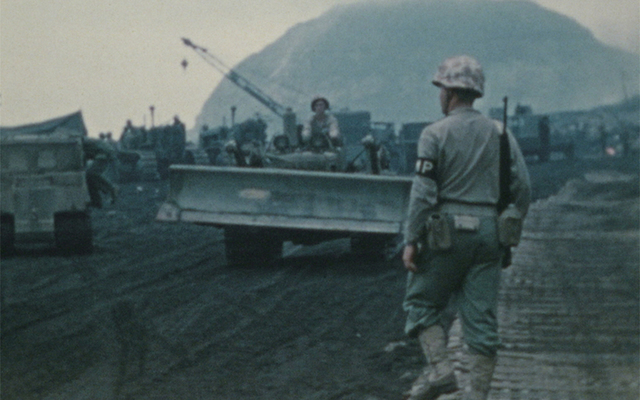Trove of Marine Corps films from 1930s-1970s to be preserved

U.S. MARINE CORPS / UNIVERSITY OF SOUTH CAROLINA / ASSOCIATED PRESS
A scene from the Battle of Iwo Jima, recorded by the U.S. Marine Corps in 1945, is part of a collection of silent, color films being preserved by the Moving Image Research Collections at the University of South Carolina in Columbia, S.C.
COLUMBIA, S.C. >> Never-before-seen films of Marines ramming artillery shells into large guns on the beaches of Iwo Jima in 1945 and standing amid sandbags during the 1968 siege of Khe Sanh in Vietnam are part of a vast collection of silent, color footage being repaired, preserved and eventually placed online for all to see.
The Marine Corps is sending the rare stockpile of films to specialists in South Carolina. Some of the images have been in storage for 70 years and offer viewers a gritty “you-were-there” view of military life. Most films were not even seen by the combat photographers who shot them with hand-held cameras from the late 1930s through World War II, Korea and Vietnam.
Marine Corps historian Thomas Baughn, who manages the film repository at the Marine Corps University at Quantico, Virginia, said it’s important the unique “Leatherneck legacy” not crumble away. Understanding the history and tradition of the Marine Corps is an important part of each Marine’s ethos, the historian said.
“It’s some pretty powerful footage,” Baughn said in a telephone interview.
The films depict storied events such as Marines wading through the tide at Guadalcanal, the wounded being evacuated from Iwo Jima and Marines tramping single-file through the hillsides after the Chinese tried to wipe out the 1st Marine Division at the Chosin Reservoir.
It is a large stockpile, about the 16,000 reels of 16 mm and 35 mm films, which amounts to about 2,000 hours.
Don't miss out on what's happening!
Stay in touch with breaking news, as it happens, conveniently in your email inbox. It's FREE!
The historian said the Marines had to look outside the government to preserve the old films because they didn’t have the capability — or money — to do it on their own. Copies of a small portion of the films have been sent to the National Archives for historical purposes, he said.
“We want to turn this into an all-digital archive, that’s the end game,” Baughn said.
Baughn said he knew specialists at the University of South Carolina had years of experience in film restoration. Also, South Carolina’s Moving Image Research Collection is part of the school’s library system, so its specialists know how to organize, catalog and digitize films, and prepare them for researchers to study.
In late December, the first large cache of 300 reels of the films arrived at the offices of Greg Wilsbacher, director of the film unit at the university.
It may take years to achieve the preservation goal because the process can be lengthy and labor-intensive, said Wilsbacher.
“It’s a big mission, but South Carolina is eager to take it on because there is such strong support for the Marine Corps here in the state,” the movie specialist said.
Half of all new male Marines — and all female Marines — undergo basic training at the Marine Corps Recruit Training Depot at Parris Island in the southern tip of the state. And the Marine Corps Air Station in Beaufort is home to several squadrons of Marine fighter squadrons.
The films will be transformed into high-definition, which offers a depth of color and detail that was unable to be seen years ago, Wilsbacher said.
The average person could find some scenes jarring.
“Seeing men in amphibious assault vehicles, moving forward and knowing in the context that some of the Marines you see will not live to come home, can be a difficult viewing experience,” Wilsbacher said.
Much work needs to be done to bring the archive to the public.
For example, a special cold-storage vault must be constructed to store the film at 45 degrees Fahrenheit and 35 percent humidity, because the older film can be harmed by high temperatures and damp conditions, Wilsbacher said. The vault should be about 2,100 square feet, or about half a basketball court.
Fielding Freed, who served in the Corps from 1983 to 1987 and was given a preview of some of the films, said he realized the impact they might have after he read a name on the uniform of a Marine shown directing traffic in Vietnam.
“How great is that going to be for his family, his great-grandchildren and grandchildren, to identify that man there on that beach?” Freed said.
One response to “Trove of Marine Corps films from 1930s-1970s to be preserved”
Leave a Reply
You must be logged in to post a comment.




Millennial need to learn to learn how this country fought for our freedom.